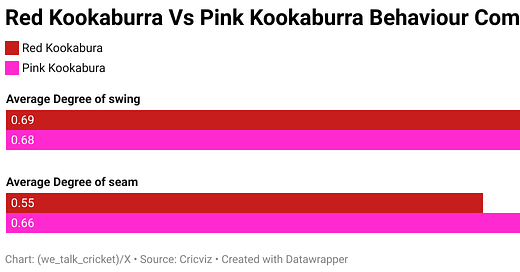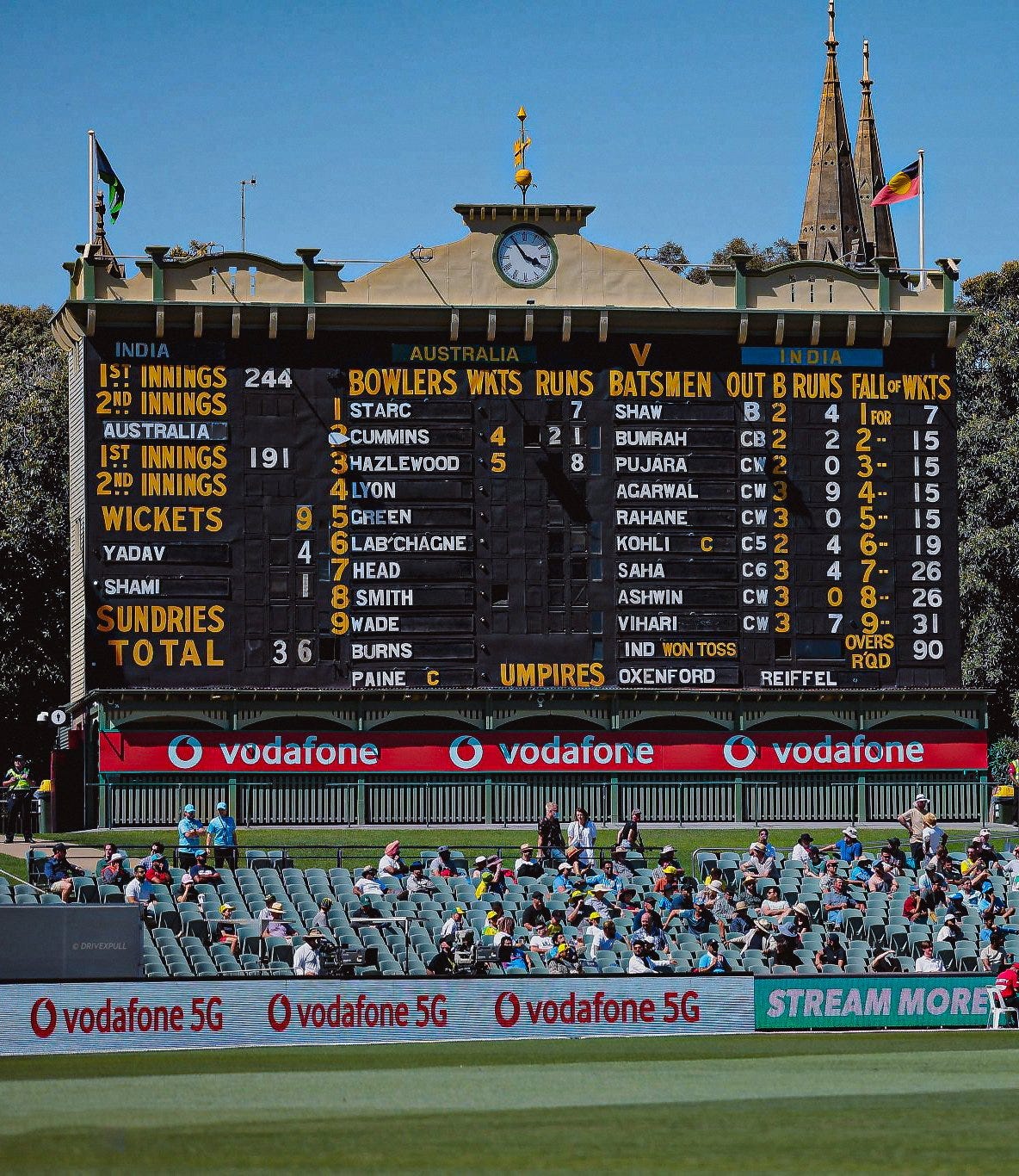SNEAK IN EARLY: A Statistical Visualization of Day/Night Test, Adelaide Oval.
A Pink Ball contest where Australia's future turns into either Day or Night. Can Australia maintain its unbeaten streak in D/N games at Adelaide against confident India?
An Unexpected Turnaround
Coming into this series on the back of a whitewash against New Zealand at home, no one expected India to win or even compete with Australia at Perth, arguably the world’s bounciest pitch. But they ended up winning the match with a comprehensive margin of 295 runs.
Now, that the confidence is back along with the expectation of winning among Indian players and their fans. Let’s see how they carry this going forward in the series, especially on the ground where they faced “The Nightmare”.
India got bundled out for 36 when they played last time a D/N match here in Adelaide.
Australian Cricket Team without “THE AUSSIE OOMPH“
Losing is one thing but the way you lose it is another. The way Australians played the game in terms of batting, bowling, and strategy was not what you imagined before the series. They were timid in their batting approach.
Especially, the usage of short deliveries and the personnel to do that bouncer barrage duty were utterly disappointing to see as an observer of the game. Yes, I am talking about using Marnus Labuschagne to bounce out Indian batters and safeguarding their premier fast bowlers for the upcoming matches. They somehow have to bring that back and ask more questions about Indian batter’s pull/hook skills.
The Result they not only lost the match, but they also lost the AUSSIE FIRE. Can’t wait to see how they bounce back from here on.
Adelaide and its nature in D/N games
Generally, Adelaide is a batting-friendly ground. In D/N games, it stays true to its nature apart from the pink ball attributes. Later in the piece, I elaborated on the pink ball and its attributes with more data. It will surprise most people. Now, Read on.
Batting becomes difficult as the game progresses. As far as the Average score is concerned, it is around 400 in 1st Innings, and for other innings refer to the above chart. (Hover over the chart to know the exact values.)
In terms of day’s play, only days 3 & 5 seem difficult to bat. Day 5 has an average of 12 wickets. Day 1 has the least number of wickets fallen on average. (Refer above chart and hover over the bar to know the exact values)
The team batting first has a slight edge in terms of winning the match during D/N games in Adelaide.
Pacers vs Spinners:
In Adelaide, the bounce won’t be a factor. Hence, spinners are not very effective unless the pitch breaks on days 4 & 5. Spinners come into the picture mostly after the 1st Innings and to the surprise of many Nathan Lyon is the highest Wicket-Taker in this ground.
Overall Comparison of Pacers and Spinners taking Runs per Wicket(Bowling Average) and Balls per Wicket(Bowling Strike Rate) as metrics for better understanding
That is reflected in Nathan Lyon’s performance here in Adelaide even though he is the highest Wicket-Taker with an overall Bowling average of 23.85 when we look further into his Innings-Wise performance his Bowling average in 1st innings during D/N matches is 38.75 and started to drop significantly in other innings.
Refer to the below charts for their innings-wise comparison to get a more precise understanding of their performance (Hover over the charts to know the exact values.)
In terms of Wicket-taking length, the Good length area is where the bowler should operate as the bowler won’t be getting much movement in the air on this ground even the Pink Kookaburra does not move much in the air compared to Red Kookaburra
The fact is that it seams off the surface more compared to Red Kookaburra. That is where pitching the ball in a good length area compared to fuller length works better in terms of bowling as Mohammed Siraj confirmed during the warm-up match and my analysis reflects the same where 60% of wickets taken by best bowlers are from good length (Refer to the above chart).
He said “I think that with the pink ball, it's better to bowl back of length. Because pitching it up, there's not a lot of swing, so the more you hit the deck and get it to seam, it will be better for us.”
By touching on this area of analysis, we will move on to the Pink Ball and its attributes to get a better understanding of this subject.
Pink Ball and its attributes
The general perception of the pink kookaburra ball is that it moves more in the air compared to the red kookaburra but that is not true. The fact is that red kookaburra swings more than the pink kookaburra.
For Red Kookaburra, the median seam is -0.55 or +0.55 (as shown in the above chart). Batsmen’s average is 30 (Approx.) against the ball which has a median seam of 0.55.
For Pink Kookaburra, the median seam is -0.66 or +0.66 (as shown in the above chart). Batsmen’s average is 25 (Approx.) against the ball which has a median seam of 0.66.
Pink ball seams More than Red Kookaburra and that makes it tough to play.
But in terms of swing with a new ball under lights. Yes, it does swing comparatively more than the daytime. A pink new ball moves more during sessions 2 & 3. So the fact is that playing pink new ball under lights has to do more with the familiarity factor and the vision.
Refer above chart to understand the session-wise behavior of the pink new ball in Australia (Hover Over the bar to know the exact numbers).
To get a precise idea of how the pink ball behaves in Adelaide during D/N games. I have a taken few metrics session-wise and compared them to understand the behavior of it during the game.
Runs Per Dismissal, Balls Per Dismissal, and Run-Rate. The below chart was created based on all D/N games played in Adelaide.
Analyzing it shows that batting during Session 2 is the easiest in Adelaide and it might be a surprise to many as I said before. In Adelaide, it becomes a white ball game during sessions 2 & 3. (Hover Over the bar to know the exact values).
Form Guide
India Form Guide: WLLLW (last five Tests, most recent starting from Right)
India in Adelaide Oval(D/N): Played- 1 Won- 0 Lost- 1
Australia Form Guide: WLWWL
Australia in Adelaide Oval(D/N): Played- 7 Won- 7 Lost- 0
In the Spotlight: Rohit Sharma and Marnus Labuschagne
The Indian skipper is back from his absence during the start of the series. Due to his form and a good couple of innings from a makeshift opener in these conditions, he found himself searching for a place in his preferred position. He is averaging 13.30 in his last 10 innings with one fifty to his name. So, all eyes are on Rohit Sharma to score big especially if he gets a chance to open.
Once he was the world’s best No.3. Now, Marnus Labuschagne is facing a lot of scrutiny for his batting approach. Averaging 13.66 in the last 10 innings he needs a big score to get his confidence back and make the Australian top order look more settled.
Rohit Sharma Versus KL Rahul: Who opens with Jaiswal?
Amidst a dilemma, I tried to find the answer to the much-discussed question of "Who should open for India in Adelaide?" After analyzing Rohit Sharma and KL Rahul’s past performance (position-wise) in all conditions
KL did an awesome job as a makeshift opener yet he should be back to middle order because Rohit did comparatively well as an opener in all conditions.
"ROHIT SHARMA should open in Adelaide".
For analysis, I used Batting Average and BPD(Balls per Dismissals) as a metric.
(1-2) -> Opener
(3-6) -> No.3 to No 6
Considering the latest team management and their form-based selection policy it won’t be a surprise to see Rohit Sharma batting in the middle order.
Team News and Preparation: Josh Hazlewood is out due to an injury. Mitchell Marsh is concerned about his fitness. Rohit Sharma and Shubman Gill are back.
As far as team India is concerned, they played a Pink ball warm-up match which was rain-curtailed yet they got what they wanted out of it. Gill and Rohit got some game time. Going by the warm-up game, their skipper has to move down the order and the star spinners have to wait for their chances.
Expected XI: Yashasvi Jaiswal, KL Rahul, Shubman Gill, Virat Kohli, Rishabh Pant(WK), Rohit Sharma(C), Washington Sundar, Nitish Kumar Reddy, Harshit Rana, Jasprit Bumrah, Mohammed Siraj.
Australia chose to do their preparations in the nets with a match simulation too. As Josh Hazlewood is out Scot Boland will swap his place. If Marsh is not fit then we might see Tasmania allrounder Beau Webster debut. He is averaging 50 with the bat in the ongoing Sheffield Shield 2024/25 and can bowl some decent medium-pace.
Expected XI: Usman Khawaja, Nathan McSweeney, Marnus Labuschagne, Steven Smith, Travis Head, Mitchell Marsh/Beau Webster, Alex Carey(WK), Pat Cummins(C), Mitchell Starc, Nathan Lyon, Scott Boland.
What does my predictive algorithm say?
Win the toss & bat first and the team batting first will win the match by 107 runs.
The below chart shows you the exact number of runs a team needs to score to win the game and stay competitive in terms of optimum scoring rate.
That means if a team scores anything more than 389 and between 396 in 1st innings of the match they are supposed to win the match. Likewise, it goes with other innings.
The above optimum scoring rate chart indicates the rate at which a team has to score so that they are on track to win the match if they are not losing wickets. For instance, the team bats in the 1st innings expected to score at 3.3RPO to 3.4RPO and it goes as per chart for other innings.
Verdict: Australia will win the match by a huge margin and keep their record intact in Adelaide D/N matches.
Follow us on Twitter for on-the-spot analysis and reactions.



